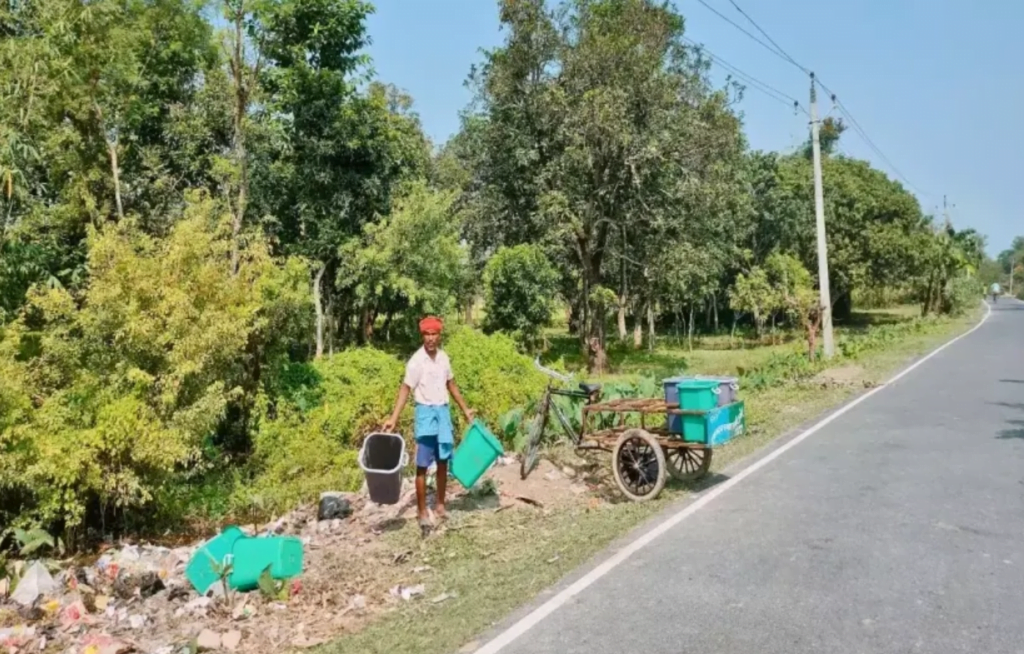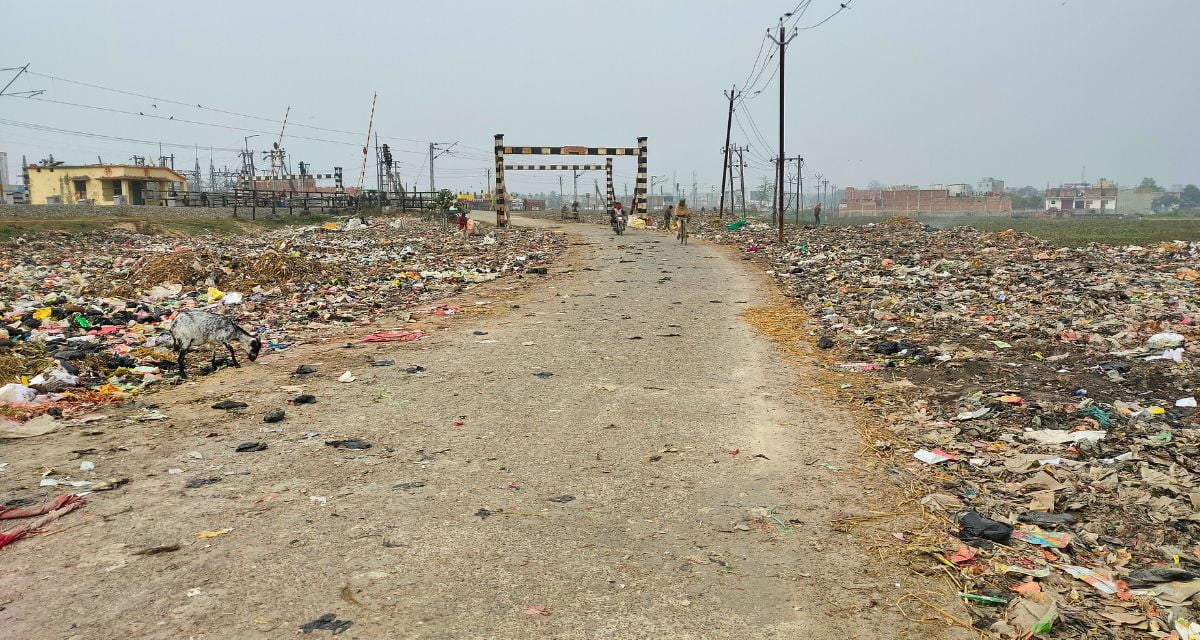By Rahul Kumar Gaurav
Supaul, Bihar: A resident of Babhangama village in Bihar’s Supaul district, Asha Devi (80) was diagnosed with a liver infection in 2013. ‘The doctor we consulted in Patna told us that the infection came either from filth or from stepping onto animal excreta. That is when we realised how harmful the garbage dump near our house was,’ said Bipul Jha, Asha Devi’s grandson.
Until 2013, the empty government land next to Bipul’s house served as a garbage dump for the 100 households in the locality. ‘We would just burn the waste once a week. But after my grandmother fell ill, we stopped people from dumping garbage here. Now, everybody digs a pit in their own fields for waste disposal,’ said Bipul.

Babhangama has four chemist stores. Apart from selling medicines, people are treated for ailments there. ‘We have kept a dustbin near the shop. Every two to three days, when it fills up with used syringes, needles, gloves and masks, we throw it in a pit dug in a field,’ said Raju Mandal, the owner of one of the stores.
In Bihar, low awareness about the disposal of biomedical waste in rural and semi-urban areas has led to the disposal of hazardous material in agricultural fields. ‘Hospital waste can be dangerous. It is not just being dumped in villages, even scrap dealers in towns are recycling and selling off biomedical waste, which poses a high risk of infection. Cattle and stray animals are more prone to diseases as they feed on littered garbage that has biomedical waste mixed in it,’ Dr Om Prakash Jha, a practising doctor from the neighbouring Saharsa district, told 101Reporters.
Shankar Mandal (65) of Bina village panchayat in Supaul has given away his land for dumping waste from about 200 houses. This includes waste from two chemist stores. ‘That piece of land has a depression. Anyway, nothing much can grow there, so I thought of serving a social purpose by allowing people to dump waste there,’ he said.
‘Unlike cities, villages do not suffer from land scarcity. Some farmers have too much land, while others are landless. People with large tracts of land usually allow dumping in a portion… However, we try to prevent them from throwing needles because they are sharp. Otherwise, it is difficult to distinguish biomedical waste from the rest,’ Shankar said.
In villages closer to towns and cities, urban local bodies do send a vehicle for garbage collection. For instance, this happens in Malhad and Karanpur villages near Supaul and in Bangaon and Mahishi near Saharsa city. But there is no segregation of biomedical waste from other garbage.
‘In the last two years, a government vehicle has been coming to collect waste. Before that, we used to throw garbage in the fields only. Now that we are on the periphery of the city, the population is increasing and farm lands are decreasing,’ said Rajesh Jha, a resident of Bangaon.

According to the World Health Organisation (WHO), only 15 per cent of the healthcare waste generated is considered hazardous. It may be infectious — like the waste contaminated with blood or other body fluids (test samples), toxic heavy metals like mercury in thermometers or chemical solvents or radioactive diagnostic materials. The WHO data claim that about 16 billion injections are administered worldwide every year, but not all of the needles and syringes are disposed of properly. Open burning and incineration of biomedical waste emits toxins such as dioxins and furans and particulate matter in the air.
What do Bio-Medical Waste Management Rules say
As per the Bio-Medical Waste Management Rules 2016, hospital and medical waste cannot be disposed of along with municipal solid waste. The rules divide biomedical waste into categories such as anatomical waste, discarded medicines and chemicals, and specify how each of them should be disposed of, the responsibility of which lies with the hospital administration itself.
As per the 2020 report of the Central Pollution Control Board (CPCB) on biomedical waste management, Bihar generated 27,846 kg of biomedical waste per day, of which only 10,201 kg was getting treated, which means 17,644 kg was being disposed of unofficially, a gap second only to Karnataka. The state has about 25,000 healthcare facilities, out of which 15,027 are yet to be authorised by the Bihar State Pollution Control Board (BSPCB) under the 2016 Rules.
As per the Central Pollution Control Board, authorisation is a tool to capture information regarding waste management by healthcare facilities as well as common biomedical waste treatment facilities. The report said the gaps in the implementation of the 2016 Rules exist because of a lack of awareness at the district level, a lack of segregation of waste within the healthcare facility and non-segregation of household waste from biomedical waste by local bodies.
Manish Kumar, media in-charge, state environment department, told 101Reporters that the department has been regularly spreading awareness about biomedical waste. ‘I cannot do anything more than this,’ he asserted.
Last November, the BSPCB sent closure notices to 1,800 health centres that failed to follow the prescribed standards under the 2016 Rules. 101Reporters asked more than 30 chemist shops in Bina, Ekma and Laukaha panchayats of Supaul about the rules, but only three were aware of them. ‘A municipality vehicle comes and takes away the garbage from our place. Many doctors also pay money for this,’ informed Pawan Kumar Jha, a compounder at the clinic of Dr DK Yadav in Supaul.

A medical representative in Supaul, on condition of anonymity, said that biomedical waste generated in Supaul was mostly thrown on a private plot located near the railway station. ‘Vehicles for waste collection are sent only to registered doctors. All others just throw it anywhere. Since municipal solid waste is mostly thrown near the railway lines, biomedical waste also ends up going there. However, there is still little awareness in cities. In villages, people do not even consider biomedical waste any different from municipal waste,’ he said.
However, the local civic body denied that biomedical waste was ending up near the railway station. ‘Only regular garbage of the town is thrown near the railway line as of now. Biomedical waste is picked up in a separate vehicle and incinerated. We have already raised a requirement to higher authorities for setting up a waste processing unit. The unit will come up as soon as land is made available. And even municipal waste will not be thrown there then,’ Krishna Swaroop, Executive Officer, Supaul Municipal Council, told 101Reporters.
Rahul Kumar Gaurav is a Bihar-based freelance journalist and a member of 101Reporters, a pan-India network of grassroots reporters.
About the author(s)
101Reporters is a pan-India network of grassroots reporters that brings out unheard stories from the hinterland.






